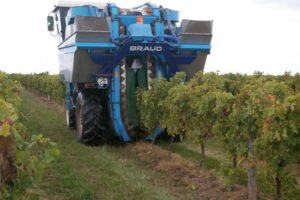It is time for the grape harvest, in the south of France. The summer has been fairly warm, and the grapes are ready to go — about a month sooner than they were a year ago.
This is a big annual event in the Languedoc and surrounding regions, which produce a third of France’s win. Grapes/wine are such a big part of everything down here. The culture, the land, the economy.
To live here is to witness the life cycle of vineyards. From leafless stumps in the winter to the green buds of spring, to the appearance of proto-bunches in early summer, to the pale green or dark purple grapes harvested in late summer that will be turned into wine in the coming months.
The most dramatic event of an oenophile’s year is the appearance of the mechanical grape harvester (as seen above), which gets the grapes off the vines in a way that I did not imagine, before living here.
I suppose I thought grape harvesting was done by hand. A bunch of people with clippers snipping off the bunches of grapes and throwing them in a big basket on their backs, with the grapes to be stamped out by feet at the end of the day.
And that does still happen, here and there, but it is very rare and meant for particularly valuable grapes, because it is very expensive to pay the number of humans it takes to harvest grapes.
Instead, the process has been mechanized for quite some time now, and requires only a couple of guys to harvest a big chunk of vines in a matter of a few hours.
Here is what they do.
(And you can watch a harvester in action at this YouTube video.)
They fire up the harvesting machines.
These are big, noisy, apparently complicated devices that are notably tall, but also wide enough to make for some tight squeezes on the narrow roads of wine country.
When we think of grapes being harvested, I think most of us have an image of a vine before us, with bunches of grapes apparent, and we will just reach in and cut them away.
The way this really happens, with the mechanical process, is from above. And it involves no cutting.
Just a lot of shaking.
Look at the photo, above, and you get an idea.
The machines collect grapes by driving over a row of vines, where a sort of flail knocks loose the grapes.
To make this possible, the harvester has a tall structure and is further lifted into the air by tall tires.
The idea is for the belly of the machine to pass over the top of the vines … and what it then does is shake the vine.
If the grapes are ripe, and near to falling off the vine, it doesn’t take a lot of shaking to break the individual grapes from each vine.
The grapes are caught in two enclosed spaces, one each above the tires, and a winnowing process keeps most leaves and branches from joining the piles of grapes, instead sending this inedible stuff over the rear of the harvester and back to the ground.
Harvest machines move along slowly, at maybe 5 miles per hour. A pedestrian can easily outpace the machine.
The machines are operated by vineyard workers who sit in a glass-enclosed cab atop the machine, perhaps eight feet above the ground. The cab has glass down around the driver’s feet, too, because it allows him to get a look at the vines as he is passing over.
After maybe 15 minutes of moving up and down rows of vines, the harvester pulls over to a side road, and the now-full twin enclosures containing the grapes are tipped up (first one, then the other) and the grapes (and a bit of juice) tumble into large trailers/wagons.
When the grapes have filled the trailer, the other man in this exercise, the driver of the tractor hauling the trailer, fires up the tractor and hauls the trailer to the area where the grapes will be crushed and the juice extracted.
To be sure, pretty much everyone concedes that shaking the vines till the grapes fall off is not an ideal way to treat the individual vine. When the harvester is finished with a patch of vines, the plants look rather battered.
A guy who works at a nearby wine shop suggests that the productive lives of vines can be shortened by 10 or 15 percent — from a lifespan that can reach 100 years — if their grapes are harvested by machine year after year.
Presumably, the people who run the wineries have done the math and the savings from harvesting via machine, rather than by hand, equal greater profits.
Watching the machines strip the vines while the driver sits in his little air-conditioned enclosure, it is impossible not to envision a dozen people, with big baskets on their backs, clip-clip-clipping the grapes 30 or 40 years ago.
The harvesters then move on to the next vineyard, and get busy.
I tend to believe that not every domaine has its own harvesting machine, given that it has to be expensive and is used no more than one month in 12. Maybe four or five small-ish domaines share the expense of one big machine and the specialist driver?
Watching the harvester work is a dramatic moment. The whole year of prepping the vines and watching them sprout and praying for rain and then praying for sun … well, it’s all done now.
The rest of it is up to chemistry, and bottling and marketing — once the harvester machine has done its thing.


0 responses so far ↓
There are no comments yet...Kick things off by filling out the form below.
Leave a Comment